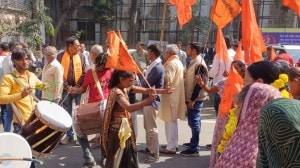Bicycles in bombings: A short history
Prime Minister Narendra Modi, during an election speech in Uttar Pradesh, appeared to suggest a connection between the 2008 Ahmedabad blasts and the Samajwadi Party due to its election symbol, the bicycle. A look at how bicycles have been used as carriers of bombs
 The police investigating the bomb blast case in Ahmedabad on July 27, 2008. Fifty-six people were killed and around 200 were injured. (Express Photo)
The police investigating the bomb blast case in Ahmedabad on July 27, 2008. Fifty-six people were killed and around 200 were injured. (Express Photo)During an election speech in Uttar Pradesh on Sunday, Prime Minister Narendra Modi appeared to suggest a connection between the 2008 Ahmedabad blasts and the Samajwadi Party (SP), wondering why the terrorists had chosen to plant bombs on bicycles, which is the SP’s election symbol.
The Election Commission of India (EC) allotted the bicycle symbol to the SP after Mulayam Singh Yadav split from the Janata Dal to form his own party in October 1992.
Under the Election Symbols (Reservation and Allotment) Order, 1968, the EC is empowered to recognise political parties and to allot them symbols.
From 2006 to 2013
Bicycles were first used as carriers of bombs in the 2006 Malegaon blasts, in which a Hindutva group led by former RSS pracharak Sunil Joshi was accused of targeting the Muslim-dominated town in Maharashtra. According to the NIA’s chargesheet, the perpetrators of the blast strapped two bombs on different bicycles and placed them in the town on September 8, 2006.
On November 23, 2007, a series of blasts occurred between 1 pm and 1.30 pm near courts in Varanasi, Lucknow, and Faizabad. The five bombs in these blasts that killed 15 people, were strapped to bicycles. Investigators later claimed the the Indian Mujahideen (IM) was behind the attacks.
Earlier that year, on May 22, 2007, three bombs kept on bicycles had gone off in Gorakhpur, injuring three persons. In December 2020, a local court convicted alleged HuJI operative Mohammad Tariq Qasmi and sentenced him to life in prison for the attacks.
On May 13, 2008, nine bombs strapped to bicycles went off at eight locations in Jaipur, killing 71 people. This was the first blast where the IM took responsibility by sending emails to various media houses.
On July 26, 2008, 22 bombs killed 56 people in Ahmedabad. Several of these bombs were found to have been fitted on bicycles. The IM claimed responsibility, and its alleged members were sentenced to death by a trial court on Friday.
On August 1, 2012, bicycles were used as bomb carriers in Pune. One person was injured in the four low-intensity blasts, and suspected IM operatives were arrested.
Less than a year later, the IM used two cycles to plant bombs at Hyderabad’s Dilsukhnagar market on February 21, 2013. Eighteen people were killed.
Around the world
Terrorist groups have long used bicycles to plant bombs. They are easy and cheap to procure anywhere in the world, and increase the impact of the blast by adding jagged metal splinters to the shrapnel from the explosion.
The first recorded case of a bicycle bomb goes back to 1939, when the Irish Republican Army left a bomb in the basket of a bicycle that exploded, killing five people in Coventry in the United Kingdom.
Thereafter, bicycle bombs were used in the 1970s, 1980s and the 1990s in the UK, and Germany, and throughout the 21st century in India, Pakistan, Sri Lanka, Afghanistan, Iraq, Russia and Spain, among other countries.
(With Manish Sahu and Anisha Dutta)



- 01
- 02
- 03
- 04
- 05



































